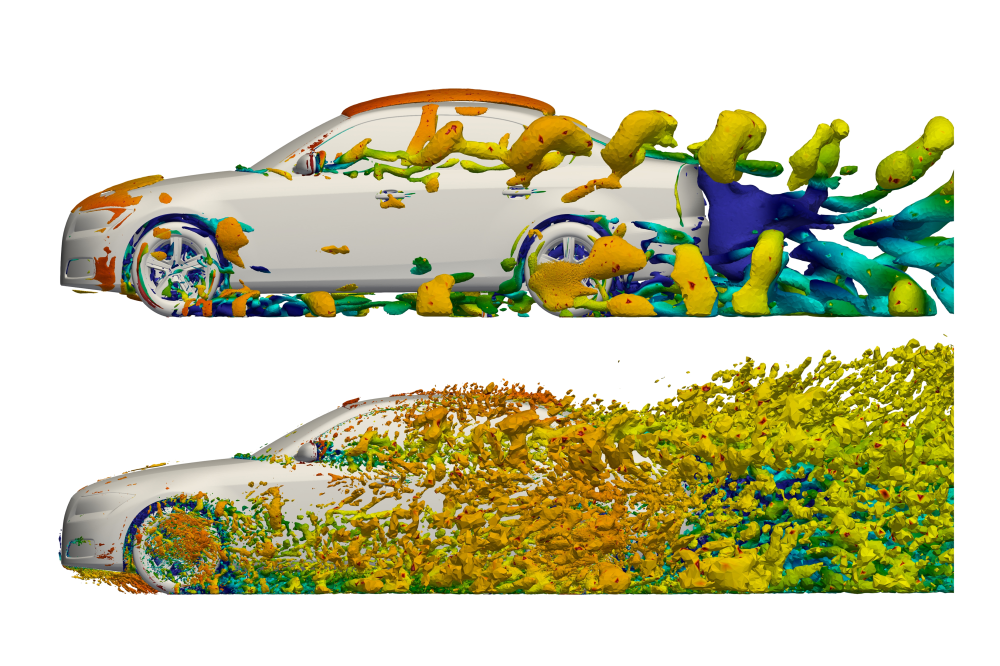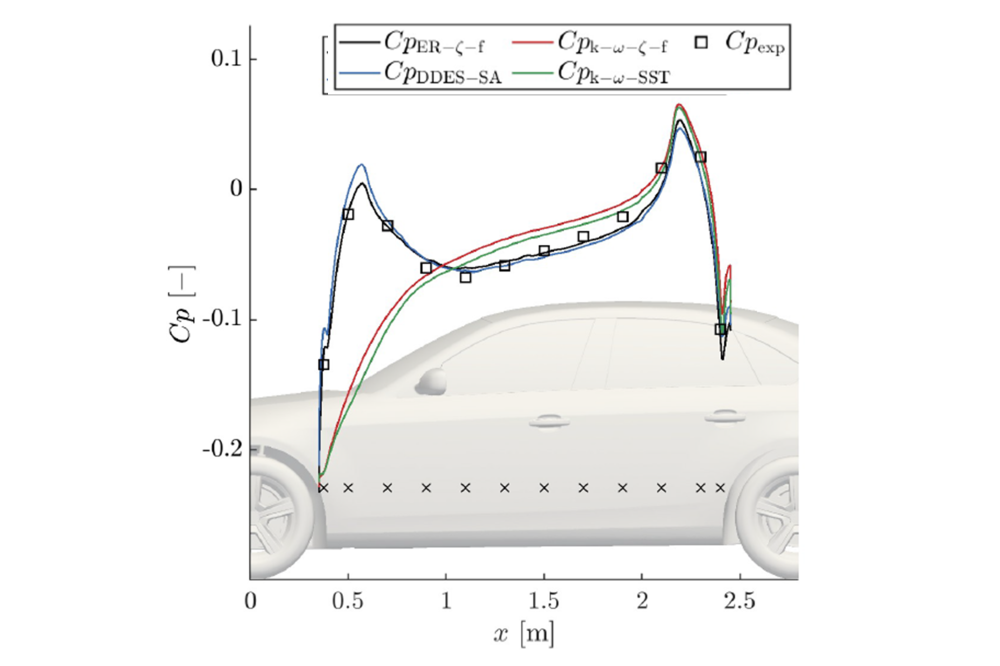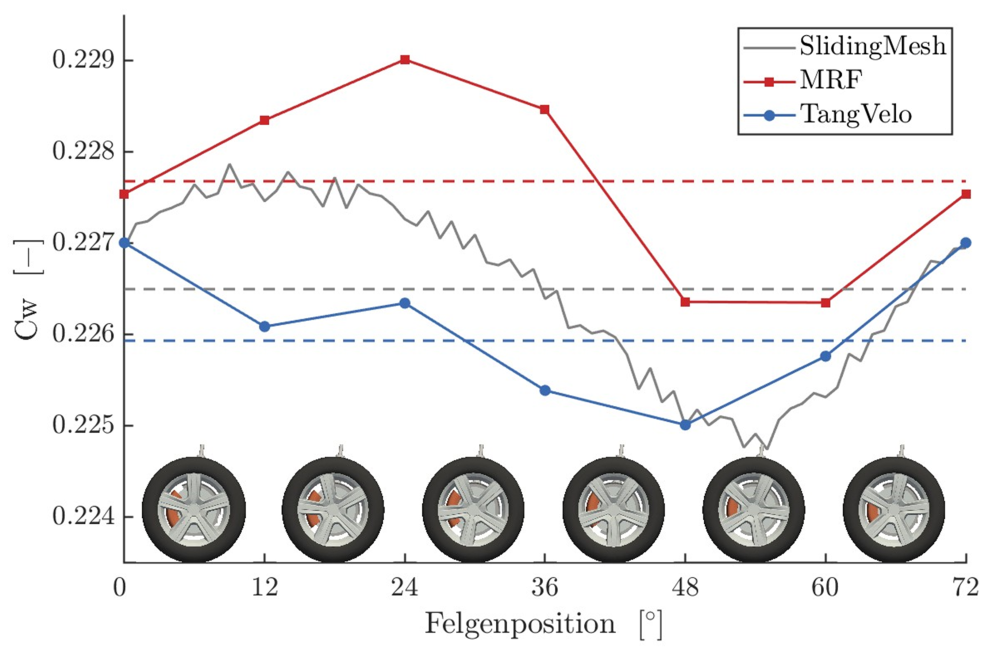Influence of Wheel Wake on Vehicle Aerodynamics: A Numerical Study using Eddy-Resolving Turbulence Models
Introduction
Motivated by the cost-cutting in the process of vehicle certification, the industry sees a growing potential in the field of computational fluid dynamics (CFD) as a means of reproducing complex flow phenomena necessary for testing the aerodynamic properties of vehicles in various configurations. Accurate simulation of wheel-related effects is the object of active research due to the complex interplay between the elastic deformations of the tires and the rotating components of the wheel. The aim of this project was to investigate the interaction between the needed meshing resolution, turbulence modeling, and methods for capturing wheel rotation while performing CFD studies of a realistic car in a wind tunnel geometry. Usage of High-Performance Computing (HPC) resources is indispensable in this case due to the large number of tested cases and the overall mesh size (ranging between tenths to hundreds of millions of cells). Experimental references in terms of integral aerodynamic coefficients, as well as pressure measurement were also taken for direct comparison.
Methods
For the CFD simulation, the finite volume (FV) method with a body-fitted mesh was used to discretize the governing flow equations. Two classes of turbulence models were used: an industry standard SA-DDES, and an in-house developed, eddy-sensitized variant of the k-ω-ζ-f model, whose resolution capabilities don’t explicitly depend on the mesh size. Both methods can be applied in (U)RANS mode, where the turbulent spectrum is completely modeled, as well as in the so called eddy-resolving (ER) mode, where the turbulent spectrum is partially
resolved, especially top-level energetic fluctuations, whereas the small scale pulsations are governed by the model of turbulence. The rotation of the whole wheel was treated by assigning the rotating-wall velocity on the tire surface. Tyres are used as slicks, without any pattern. The rotation of wheel spokes causes additional losses of energy (increase in drag - ventilation effect) and also requires detailed modeling. This effect was handled using three different methods for comparison: 1) rotating wall velocity, 2) multiple-reference frame (MRF) method, as well as the 3) sliding (rotating mesh) approach, with rotating and stationary regions in the mesh, thus increasing the physicality of the solution. For the chosen meshing resolution and a fixed combination of turbulence model/wheel rotation strategy, simulations were started in RANS mode, continued in unsteady (U)RANS mode, and finally performed in the eddy-resolving (ER) mode. Formally second-order schemes were used for discretisation of all terms in space and time.
Results
In total, around 100 different simulation cases were performed, varying the aforementioned parameters. For all three simulation stages, integral aerodynamic coefficients, as well as pressure probes, were sampled, averaged, and ultimately compared with experimental references. A comparison between the typical solution outcomes, in form of the using (U)RANS and eddy-resolving (ER) modes is shown in Figure 1, where the iso-surfaces depicting the so-called Q-criteria are shown. As can be seen, usage of (U)RANS models results in substantially smaller resolved structural content. In contrast, eddy-resolving (ER) models are capable of reproducing a more detailed insight into the flow field, down to the mesh limit.
Discussion
With respect to the choice of turbulence models, simulation results clearly point to the predominance of eddy-resolving methods, which tend to outperform the RANS models in both the prediction quality of first- and second-order statistics, especially in the zones of separation and high anisotropy. This is best illustrated in Figure 2, where the typical simulation outcome - pressure distribution around the car side surface is shown for two RANS and two ER models (as a baseline, sliding mesh approach is used in all cases for maximum physicality). Symbols denote the measured pressure coefficient, supplied from the experiment. This position is especially relevant due to the complex flow conditions established around the wheel, involving separations, secondary flows, as well as high level of anisotropy. As can be seen in the Figure 2, both eddy-resolving (ER) models are able to correctly capture the pressure distribution, despite the underlying difference in modeling formulation. On the other hand, both (U)RANS models predict a zone of substantially smaller pressure in comparison with experiment. This is especially relevant in the vicinity of the rotating wheel, where the complex flow conditions are established. Further downstream, flow becomes attached and all models perform with similar accuracy. Increase in accuracy with usage of eddy-resolving models can be attributed to the partial resolution of the spectrum, where the most energetic coherent structures, associated with the complex flow conditions are directly resolved. Hence, it can be concluded that the usage of eddy-resolving models clearly has advantages in terms of accuracy, despite the increased computational effort. Once the predominance in eddy-resolving models is established, further studies involving the accuracy of wheel rotation strategies are conducted. With ER-k-ω-ζ-f model taken as a baseline parameter, it was observed how the drag coefficient changes along the wheel rotation. This is shown in Figure 3. First, the phaseaveraged value of drag coefficient along the one full symmetric wheel rotation (72°) is observed. For sliding-mesh method, the sinusoidal change is clearly observed, whereas variations around the mean reach 2 to 3 points. As for other two competing methods, they can not be compared directly in one simulation case, since the mesh is completely stationary. However, it is possible to perform multiple simulations involving stationary mesh in which the wheel is rotated by a fixed number of degrees, until the symmetry point is reached. In total, 6 different cases were studied with stationary mesh. Results are compared with the sliding-mesh method in Figure 3. As can be seen, both methods lead to the quantitatively similar integral results, whereas the apparent sinusoidal change in drag coefficient is identified for all three methods. Deviations between the mean values also do not exceed 2 to 3 points in terms of pressure coefficient. Although this study shows that the methods of lesser complexity can also be used for reproducing the integral aerodynamic characteristics of the vehicle, by performing multiple simulations with continuously changing (but stationary) geometry, it is also bound with additional computational effort which doesn’t justify its use. Conclusions following the performed simulations show that the increase in simulation accuracy can be achieved by using the turbulence models capable of adequately resolving the turbulent spectrum, as well as methods which directly capture the effect of wheel rotation.






